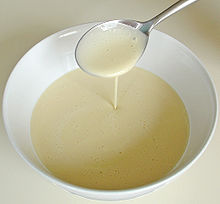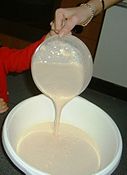
Dessert is a course that concludes a meal. The course consists of sweet foods, such as cake, and possibly a beverage such as dessert wine and liqueur. Some cultures sweeten foods that are more commonly savory to create desserts. In some parts of the world there is no tradition of a dessert course to conclude a meal.

Bread is a staple food prepared from a dough of flour and water, usually by baking. Throughout recorded history and around the world, it has been an important part of many cultures' diet. It is one of the oldest human-made foods, having been of significance since the dawn of agriculture, and plays an essential role in both religious rituals and secular culture.

Baking is a method of preparing food that uses dry heat, typically in an oven, but can also be done in hot ashes, or on hot stones. The most common baked item is bread, but many other types of foods can be baked. Heat is gradually transferred "from the surface of cakes, cookies, and pieces of bread to their center. As heat travels through, it transforms batters and doughs into baked goods and more with a firm dry crust and a softer center". Baking can be combined with grilling to produce a hybrid barbecue variant by using both methods simultaneously, or one after the other. Baking is related to barbecuing because the concept of the masonry oven is similar to that of a smoke pit.

Cake is a flour confection made from flour, sugar, and other ingredients and is usually baked. In their oldest forms, cakes were modifications of bread, but cakes now cover a wide range of preparations that can be simple or elaborate and which share features with desserts such as pastries, meringues, custards, and pies.

Pastry is baked food made with a dough of flour, water, and shortening that may be savoury or sweetened. Sweetened pastries are often described as bakers' confectionery. The word "pastries" suggests many kinds of baked products made from ingredients such as flour, sugar, milk, butter, shortening, baking powder, and eggs. Small tarts and other sweet baked products are called pastries as a synecdoche. Common pastry dishes include pies, tarts, quiches, croissants, and pasties.

Tempura is a typical Japanese dish that usually consists of seafood and vegetables that have been coated in a thin batter and deep fried.
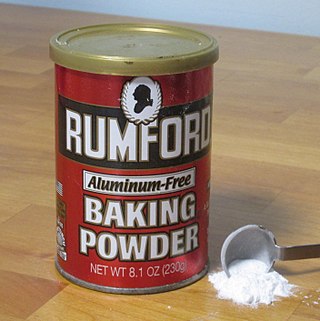
Baking powder is a dry chemical leavening agent, a mixture of a carbonate or bicarbonate and a weak acid. The base and acid are prevented from reacting prematurely by the inclusion of a buffer such as cornstarch. Baking powder is used to increase the volume and lighten the texture of baked goods. It works by releasing carbon dioxide gas into a batter or dough through an acid–base reaction, causing bubbles in the wet mixture to expand and thus leavening the mixture. The first single-acting baking powder was developed by food manufacturer Alfred Bird in England in 1843. The first double-acting baking powder, which releases some carbon dioxide when dampened and later releases more of the gas when heated by baking, was developed by Eben Norton Horsford in the U.S. in the 1860s.
In cooking, a leavening agent or raising agent, also called a leaven or leavener, is any one of a number of substances used in doughs and batters that cause a foaming action that lightens and softens the mixture. An alternative or supplement to leavening agents is mechanical action by which air is incorporated. Leavening agents can be biological or synthetic chemical compounds. The gas produced is often carbon dioxide, or occasionally hydrogen.

Cornbread is a quick bread made with cornmeal, associated with the cuisine of the Southern United States, with origins in Native American cuisine. It is an example of batter bread. Dumplings and pancakes made with finely ground cornmeal are staple foods of the Hopi people in Arizona. The Hidatsa people of the Upper Midwest call baked cornbread naktsi. Cherokee and Seneca tribes enrich the basic batter, adding chestnuts, sunflower seeds, apples, or berries, and sometimes combine it with beans or potatoes. Modern versions of cornbread are usually leavened by baking powder.
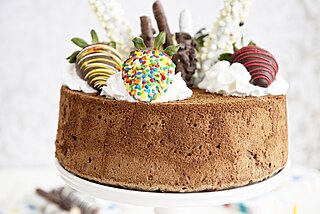
Angel food cake, or angel cake, is a type of sponge cake made with egg whites, flour, and sugar. A whipping agent, such as cream of tartar, is commonly added. It differs from other cakes because it uses no butter. It’s aerated texture comes from whipped egg white. Angel food cake originated in the United States and first became popular in the late 19th century. It gained its unique reputation along with its name due to its light and fluffy texture and white color.

Seitan is a food made from gluten, the main protein of wheat. It is also known as miànjīn, fu, milgogi, wheat meat, gluten meat, vital wheat gluten or simply gluten. It is made by washing wheat flour dough with water until most of the starch granules have been removed, leaving behind the sticky, insoluble gluten as an elastic mass, which is then cooked and eaten.

Dough is a thick, malleable, sometimes elastic paste made from grains or from leguminous or chestnut crops. Dough is typically made by mixing flour with a small amount of water or other liquid and sometimes includes yeast or other leavening agents, as well as ingredients such as fats or flavorings.

Shortbread or shortie is a traditional Scottish biscuit usually made from one part white sugar, two parts butter, and three to four parts plain wheat flour. Shortbread does not contain any leavening, such as baking powder or baking soda. Shortbread is widely associated with Christmas and Hogmanay festivities in Scotland, and some Scottish brands are exported around the world.
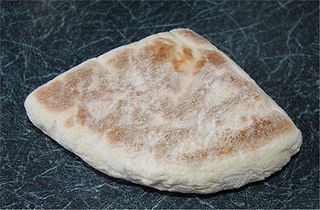
Soda bread is a variety of quick bread traditionally made in a variety of cuisines in which sodium bicarbonate is used as a leavening agent instead of the traditional yeast. The ingredients of traditional soda bread are flour, baking soda, salt, and buttermilk. The buttermilk in the dough contains lactic acid, which reacts with the baking soda to form tiny bubbles of carbon dioxide. Other ingredients can be added, such as butter, egg, raisins, or nuts. An advantage of quick breads is their ability to be prepared quickly and reliably, without requiring the time-consuming skilled labor and temperature control needed for traditional yeast breads.
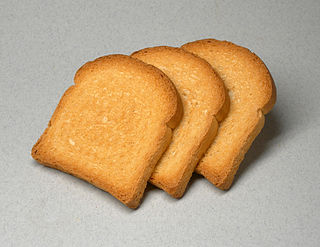
A rusk is a hard, dry biscuit or a twice-baked bread. It is sometimes used as a teether for babies. In some cultures, rusk is made of cake, rather than bread: this is sometimes referred to as cake rusk. In the UK, the name also refers to a wheat-based food additive.

Boxty is a traditional Irish potato pancake. The dish is mostly associated with the north midlands, north Connacht and southern Ulster, in particular the counties of Leitrim, Mayo, Sligo, Fermanagh, Longford, and Cavan. There are many recipes but all contain finely grated, raw potatoes and all are served fried.

Quick bread is any bread leavened with a chemical leavening agent rather than a biological one like yeast or sourdough starter. An advantage of quick breads is their ability to be prepared quickly and reliably, without requiring the time-consuming skilled labor and the climate control needed for traditional yeast breads.

Beer bread is any bread that includes beer in the dough mixture. Depending on the type of beer used, it may or may not contribute leavening to the baking process. Thus, beer breads range from heavy, unleavened, loaves to light breads and rolls incorporating baker's yeast. The flavor of beer bread is sometimes enhanced with other flavors, such as cheese or herbs.

Sponge cake is a light cake made with eggs, flour and sugar, sometimes leavened with baking powder. Some sponge cakes do not contain egg yolks, like angel food cake, but most of them do. Sponge cakes, leavened with beaten eggs, originated during the Renaissance, possibly in Spain. The sponge cake is thought to be one of the first non-yeasted cakes, and the earliest attested sponge cake recipe in English is found in a book by the English poet Gervase Markham, The English Huswife, Containing the Inward and Outward Virtues Which Ought to Be in a Complete Woman (1615). Still, the cake was much more like a cracker: thin and crispy. Sponge cakes became the cake recognised today when bakers started using beaten eggs as a rising agent in the mid-18th century. The Victorian creation of baking powder by English food manufacturer Alfred Bird in 1843 allowed the addition of butter to the traditional sponge recipe, resulting in the creation of the Victoria sponge. Cakes are available in many flavours and have many recipes as well. Sponge cakes have become snack cakes via the Twinkie.
